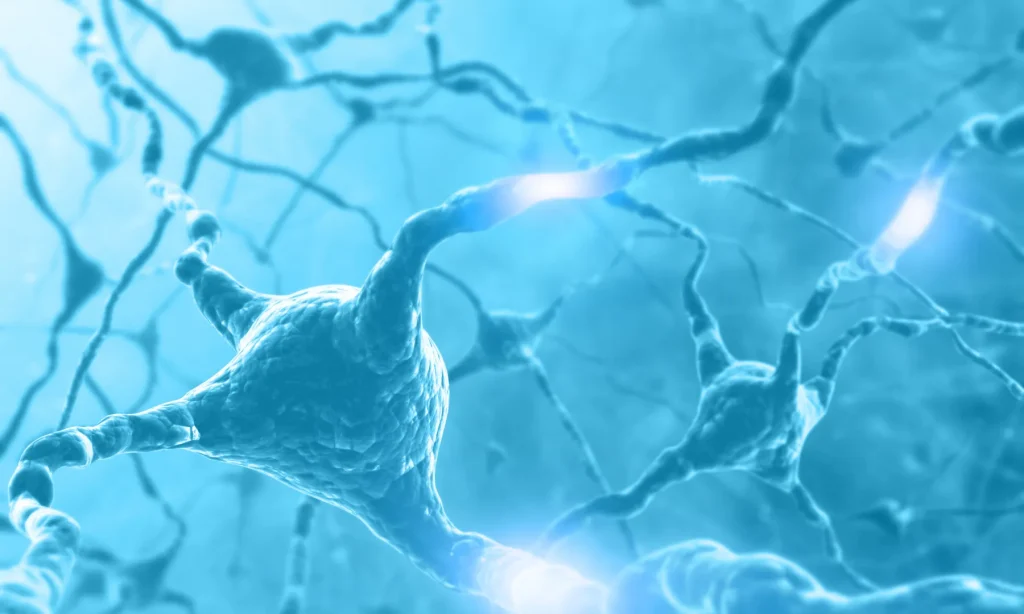Have you ever stopped to ask what’s really happening in the brain when a tic shows up? Those quick, involuntary movements or sounds might look unpredictable, but they are closely connected to the complex chemical signals that shape brain function. At the center of this connection are tics and neurotransmitters, the messengers that help nerve cells talk to each other. When these signals become unbalanced, the ripple effect can show up as tic disorders.
Exploring this link is more than an academic exercise—it’s a way to gain insight into why tics occur and how to support long-term health. Experts like Dr. Piper Gibson highlight the importance of looking beyond symptoms and considering the bigger picture. That’s why consulting with a functional medicine expert in tic disorders can be a decisive step for families searching for answers. By learning how these chemical messengers influence the brain and body, you can better understand the challenges at play and the possibilities for restoring balance.
Key Takeaways
-
Tics and neurotransmitters are deeply connected, with chemical imbalances in the brain often driving the occurrence of motor and vocal tics.
-
Dopamine, serotonin, GABA, and glutamate are key neurotransmitters involved in tic disorders, each playing distinct roles in movement, mood, and brain balance.
-
Gut health impacts neurotransmitter production, as the gut produces a significant portion of serotonin and influences brain function through the gut-brain axis.
-
Stress, inflammation, and nutrient deficiencies can disrupt neurotransmitter balance, leading to heightened tic severity and frequency.
-
Functional testing and holistic interventions, including dietary changes, addressing inflammation, and targeted supplementation, can help restore balance and manage tics effectively.
-
A personalized approach, integrating functional medicine and lifestyle adjustments, offers sustainable strategies to support neurotransmitter health and reduce tic symptoms.
Table of Contents
What Are Neurotransmitters and What Do They Do?
Neurotransmitters are like the text messages of your brain, only instead of emojis and memes, they’re chemical signals that let different parts of your brain and body chat with each other. These little messengers are responsible for keeping things running smoothly, from your emotions to your movements.
The Major Players: Dopamine, Serotonin, GABA, Glutamate
When it comes to tics, four key neurotransmitters often take center stage: dopamine, GABA, serotonin and glutamate, think of them as the cast of a play, each with a different role in shaping your child’s signs.
-
Dopamine is your brain’s hype man. It fuels motivation, coordinates movement, and even lights up when your kid achieves something exciting (like finally getting those tricky shoelaces tied!). In tic disorders, though, too much dopamine can create hyperactivity or compulsive behaviors.
-
Serotonin, often called the mood stabilizer, handles more than just happiness. It’s tied to anxiety, OCD-like behaviors, and even tics when its levels fall out of balance—kind of like an orchestra out of tune.
-
GABA is your brain’s chill pill. This neurotransmitter works to calm overactive signals. If there’s not enough GABA, those hectic brain signals can lead to more frequent and intense tics.
-
Glutamate balances out GABA as an excitatory neurotransmitter—it energizes brain activity. But too much glutamate? That can spark overstimulation or what some experts call “glutamate storms,” especially in inflamed or stressed-out brains.
Their Roles in Motor Control, Inhibition, and Excitation
Neurotransmitters don’t just sit in the background—they actively shape movement and behavior. Here’s the breakdown of their roles and how they can influence tics.
|
Neurotransmitter |
Role |
Impact on Tics |
|---|---|---|
|
Dopamine |
Drives reward and motor activity |
Overactive dopamine can lead to hyperactivity and compulsive tics |
|
Serotonin |
Modulates mood and inhibitions |
Low serotonin often brings anxiety, OCD traits, and tics |
|
GABA |
Calming, inhibitory effects |
Too little GABA = brain overdrive, more tics |
|
Glutamate |
Excitatory stimulation |
High levels may cause “excitotoxicity,” fueling more tics |
The Dopamine-Tic Connection
Dopamine is a key neurotransmitter that drives movement, attention, and reward. When it becomes unbalanced, it can fuel tics and neurotransmitter disruptions, making it one of the most studied chemicals in tic disorders.
Why Dopamine Is Often the Focus of Tic Disorders
Individuals with tic disorders often have dopaminergic hypersensitivity in the basal ganglia, the brain’s movement control hub. This oversensitivity makes regular dopamine activity feel amplified, which can trigger sudden, unwanted tics along with hyperactivity or agitation.
Dopaminergic Hypersensitivity in the Basal Ganglia
In a healthy brain, dopamine input is regulated smoothly. In tic disorders, the basal ganglia respond too strongly, almost like a switch that reacts wildly to minor changes. This heightened response is strongly associated with the motor and vocal symptoms seen in tic conditions.
How Stimulant Medications and Dopamine Interact
Stimulants prescribed for ADHD, such as methylphenidate or amphetamines, raise dopamine levels. For some children, this helps with focus and self-control, but in others, it can worsen tic frequency. Careful dosing and monitoring are essential, and if tics intensify, families can explore alternatives such as behavioral therapy, targeted supplementation, or functional lab testing with a healthcare provider.

GABA and Glutamate: The Balancing Act
Two of the most essential neurotransmitters in tic disorders are GABA and glutamate. GABA acts as the brakes, calming brain activity, while glutamate acts as the gas pedal, stimulating movement and learning. When these two fall out of balance, tics often become more frequent or intense.
GABA – The Brakes
GABA slows down overactive signals in the brain, helping regulate movement and reduce overstimulation. Low GABA levels weaken this braking system, leading to anxiety, dysphoria, and more frequent motor or vocal tics. Children with low GABA may also experience constipation or restless evenings, since glutamate normally converts to GABA later in the day to promote calm. Supporting GABA through calming routines, nutrition, or targeted supplementation can help restore balance.
Glutamate – The Gas Pedal
Glutamate drives learning, memory, and movement, but excess levels can trigger a “glutamate storm,” flooding the brain with excitatory activity. These storms are often tied to inflammation, when brain immune cells (microglia) release too much glutamate. The overload increases calcium in neurons, a process called excitotoxicity, which worsens tics and stresses brain cells over time. Reducing triggers like processed foods or focusing on anti-inflammatory diets—sometimes a focus for those exploring tics and gut health or epigenetics—could help balance the brain’s glutamate levels.
Imbalances and the Onset of Motor/Vocal Tics
Tics arise when glutamate and GABA lose their balance. Too much glutamate without enough GABA is like a runaway train, overstimulating motor circuits and driving involuntary movements or sounds. This explains why functional interventions often aim to regulate the entire system instead of only suppressing tics. Mindfulness practices, lab testing, and specific nutritional support are some of the ways to help restore equilibrium between these two neurotransmitters.
Serotonin’s Role in Mood and Tic Disorders
Anxiety, OCD, and Tic Comorbidity
Serotonin is central to mood regulation and strongly tied to anxiety and obsessive-compulsive disorder (OCD), both of which often occur alongside tic disorders. When serotonin levels are imbalanced, anxiety and compulsions can intensify, making tics more severe and frequent.
Most serotonin is produced in the gut, which means gut health directly affects how much is available to the brain. Inflammation, poor diet, or deficiencies in nutrients such as vitamin B6, folate, and magnesium can reduce serotonin production. Addressing these gaps through diet, targeted supplements for tic disorders, and gut support may help ease anxiety and obsessive thinking, which in turn can lessen tic flare-ups.
SSRIs and Their Effects on Tics
Selective serotonin reuptake inhibitors (SSRIs) are often prescribed to help manage anxiety or OCD by stabilizing serotonin levels. While they may reduce the emotional stressors that worsen tics, they do not directly address the tics themselves. In some children, SSRIs bring noticeable relief; in others, the impact is limited.
Because serotonin is only one part of the puzzle, broader evaluation is often needed. Functional lab testing for tic disorders can help uncover whether imbalances in neurotransmitters, nutrient deficiencies, or gut issues are contributing to symptoms. This data-driven approach allows families move beyond trial and error and create strategies that support the whole system rather than targeting tics alone.
Functional and Holistic Insights into Neurotransmitter Imbalance
Tics often reflect deeper communication issues between the brain and body. Understanding how neurotransmitter imbalances arise can highlight practical steps to reduce their impact.
Gut-Brain Axis and Neurotransmitter Production
About 90% of the body’s serotonin is made in the gut. Disruptions such as food sensitivities, parasites, or candida can interfere with this process, contributing to tic flare-ups. Leaky gut compounds the problem by weakening nutrient absorption, especially proteins needed for amino acids—the raw materials for neurotransmitters. Restoring gut health through diet changes or probiotics may help rebalance both digestion and neurological activity.
Nutrient Deficiencies (B6, Magnesium, Zinc, Iron)
Neurotransmitter production depends on specific nutrients that act as cofactors. Deficiencies in B6, magnesium, zinc, or iron slow down the conversion of proteins into functional neurotransmitters. For example, magnesium naturally calms overactive signals, zinc regulates excitatory activity, and B6 supports serotonin synthesis. Addressing these gaps helps the brain maintain steadier control over tics and mood.
Inflammation as a Hidden Trigger
Chronic inflammation activates microglia, the brain’s immune cells, releasing excess glutamate and creating a cycle of overstimulation. This often makes tics worse. Mast cell activation and histamine responses can intensify the effect. Reducing inflammatory triggers such as processed foods and adding anti-inflammatory nutrients like omega-3s or turmeric may lower this burden. Specialists, including those at Regenerating Health led by Dr. Piper Gibson, often look closely at these immune-driven factors when addressing tic disorders.
Genetics & Epigenetics
Genetic predispositions can make some children more prone to low GABA or high glutamate activity, both of which influence tic severity. Methylation challenges, which affect how the body processes nutrients, also impact neurotransmitter production. Epigenetics shows that lifestyle and nutritional support can help counter these tendencies, allowing for more balanced brain activity despite underlying genetic factors.

Why Neurotransmitters Go Out of Balance in Tic Disorders
Tics and neurotransmitters are closely linked, and several hidden factors can push this system off balance. Understanding these drivers can reveal why tics worsen and how to address them.
Chronic Stress, Poor Detox, and Inflammation
Chronic stress floods the body with cortisol, disrupting dopamine and serotonin. If detox pathways like the liver and kidneys are under strain, toxins accumulate, adding more pressure. For children with tic disorders, this combination often increases inflammation and raises glutamate activity, intensifying tics. Food sensitivities and cytokine overactivation can exacerbate the problem.
Gut Dysbiosis and Neurotransmitter Disruption
Around 90% of serotonin is produced in the gut. Dysbiosis—imbalances in bacteria, yeast, or parasites—interferes with this process, lowering serotonin and disrupting brain communication. The result can include tics alongside anxiety, poor sleep, and mood issues. Restoring gut health with fiber, probiotics, and anti-inflammatory foods helps normalize production.
Hidden Infections and Environmental Toxins
Infections like strep (seen in PANS/PANDAS) can trigger inflammation that disturbs neurotransmitter balance. Environmental toxins such as pesticides or heavy metals damage brain pathways, worsening tic activity. Reducing toxin exposure through safer household products and clean water testing can be part of the solution.
Testing and Addressing Neurotransmitter Imbalances
The Problem with Plasma-Only Testing
Plasma tests measure neurotransmitters in the blood but miss what is inside cells. Urine tests detect metabolites but not active levels in the brain. These methods provide partial insight, which can lead to incomplete or inconsistent treatment results.
Functional Testing That Works
More comprehensive tools give a clearer picture:
-
Organic Acids Test (OAT): Provides detailed data on neurotransmitter metabolites.
-
Comprehensive Neuroimmune Analysis: Tracks up to 935 biomarkers, highlighting inflammation, histamines, and immune activity.
-
Stool Testing: Identifies gut imbalances, food sensitivities, and hidden infections.
Together, these tests reveal how brain and body systems interact, creating a reliable foundation for treatment planning.
Functional Medicine Interventions
Once testing clarifies the imbalances, interventions focus on long-term regulation:
-
Food first: High-quality protein, nutrient-rich foods, and reduced processed intake to support neurotransmitter production.
-
Supplements for tic disorders: Magnesium, B6, zinc, folate, and vitamin D can support balance when guided by a professional such as Dr. Piper Gibson.
-
Lifestyle changes, including better sleep, stress management, and lower inflammation, help regulate brain chemistry.
-
Restorative Rescue Strategy: A structured plan that emphasizes steady progress instead of quick fixes.
This comprehensive approach connects diet, lifestyle, and testing into a unified system that strengthens resilience against tics.
Final Thoughts: Rebalancing the Brain, Holistically
Tics are not isolated events; they reflect how the brain and body communicate through neurotransmitters, gut health, immune balance, and genetics. Addressing these areas together creates a more straightforward path to reducing tic frequency and supporting overall well-being.
A functional medicine approach brings these factors into focus, using testing, nutrition, and lifestyle strategies to build long-term stability. Working with a functional medicine expert in tic disorders helps families move beyond guesswork and toward solutions tailored to their child’s unique needs. Professionals such as Dr. Piper Gibson guide this process with an emphasis on practical steps that restore balance and strengthen resilience.
Taking a whole-body perspective allows progress to unfold steadily, giving children and families the tools to manage challenges better and move forward with greater confidence.
If you are ready to dig deeper into your child’s tic disorder, click here and start with the Tic Disorder Cheat Sheet.
Frequently Asked Questions
Tics are involuntary movements or sounds that often arise when the brain’s signaling chemicals miscommunicate. Neurotransmitters like dopamine, GABA, glutamate, and serotonin help regulate movement and inhibition. Disruption in their production, conversion, or balance can increase tic frequency or severity.
Dopamine plays a major role in movement control. In many children with tic disorders, brain regions like the basal ganglia are overly responsive to dopamine, making even normal signals produce exaggerated movements or sounds. Treatments often target this sensitivity to reduce tics.
Yes. Glutamate is an excitatory neurotransmitter. When levels are too high, it can overstimulate neurons and trigger what’s sometimes called “excitotoxicity,” worsening tics. Balancing glutamate with calming neurotransmitters (like GABA) helps reduce this risk.
The gut produces a large portion of key neurotransmitters, such as serotonin. When gut function is disrupted by dysbiosis, food sensitivities, or inflammation, nutrient absorption suffers, crucial amino acids may be missing, and neurotransmitter production becomes compromised, which can aggravate tics.
Deficiencies in vitamin B6, magnesium, zinc, iron (and sometimes folate) are often observed. These micronutrients act as cofactors in neurotransmitter synthesis and regulation. When levels are inadequate, processes like calming signals or inhibitory control weaken, making tics more likely or intense.
Yes. Inflammation activates immune processes and brain immune cells (microglia), which can raise glutamate levels and interfere with GABA and serotonin. This imbalance often correlates with increased tic activity, especially following illness, stress, or repeated immune stressors.
Absolutely. Stress elevates cortisol and other hormones, which can disrupt neurotransmitter production. Poor sleep impairs restorative processes. Disrupted routines or overstimulation interfere with balance among dopamine, GABA, serotonin, and glutamate, often leading to more frequent or severe tics.
Tests like organic acids testing, urine metabolite panels, neuroimmune marker assessment, genetic methylation profiles, and gut microbiome/stool analysis are useful. These help identify which neurotransmitters are out of range, nutrient deficiencies, or gut/immune disruptions contributing to symptoms.
No. Medications targeting dopamine or other neurotransmitters are one tool, but many children benefit from non-pharmacologic strategies. Behavior therapies, dietary support, optimizing micronutrients, stress reduction, and improving gut health all play important roles in reducing tic severity.
Every child responds differently. Some may notice improvements in weeks when micronutrient gaps and diet are addressed, while others may require months of consistent lifestyle, stress management, and possibly supplementation. Long-term support and monitoring generally lead to more stable outcomes.
References:
Schüller, C. B., van der Most, H., van Elst, L. T., Ebert, D., & Maier, S. (2021). Temporal discounting in adolescents and adults with Tourette syndrome. PLoS ONE, 16(6), Article e0253620. https://doi.org/10.1371/journal.pone.0253620
Palumbo, D., Maughan, A., Kurlan, R., Carlson, G., & Geller, D. (2004). Emergence of tics in children with ADHD: Impact of once-daily OROS methylphenidate therapy. Journal of Child and Adolescent Psychopharmacology, 14(2), 185–194. https://doi.org/10.1089/1044546041649138
He, J. L., Stromberg, E. A., Ramirez, C. A., Worbe, Y., Murphy, D. L. M., Serrien, D. J., & Beste, C. (2022). Frequency and intensity of premonitory urges-to-tic in Tourette syndrome is associated with supplementary motor area GABA+ levels. Movement Disorders, 37(3), 563–573. https://doi.org/10.1002/mds.28868
Geller, D. A. (2006). Obsessive-compulsive and spectrum disorders in children and adolescents. Psychiatric Clinics of North America, 29(2), 353–370. https://doi.org/10.1016/j.psc.2006.02.012
Xie, Y., Wang, C., Zhao, D., Wang, C., & Li, C. (2020). Dietary proteins regulate serotonin biosynthesis and catabolism by specific gut microbes. Journal of Agricultural and Food Chemistry, 68(21), 5880–5890. https://doi.org/10.1021/acs.jafc.0c00832

